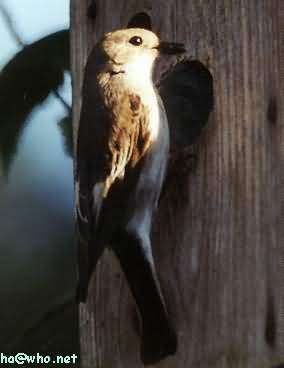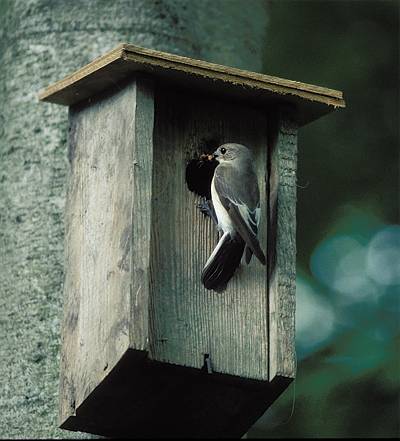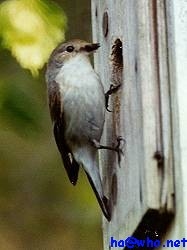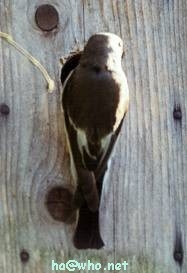Pied Flycatcher
66 secs / 194 kb / MP3

The Pied Flycatcher is a frequent breeder in our garden
Beautiful black and white bird that used to turn up in our garden almost every year for about a week. It used to fight heavily with the Great Tit, which is just a bit bigger, and the Blue Tit, which is a bit smaller, but by no means less agressive, over the possession of the nesting boxes in our garden. The Flycatcher returns late from Africa and that is why it finds all the boxes occupied. In all previous years the Flycatcher lost the battles and disappeared after a week or so. In 1999 however one of the nesting boxes remained unoccupied. The Flycatcher immediately took advantage and started to use the box. Alas its young left the nest on a working day, so we have no record of that happy moment.


To the left the darker male and to the right the paler female of the Pied Flycatcher.
In 2001 we had another breeding case in our garden. However another box was used, situated in the back garden. The bird is known to spread cross Europe rapidly during the last decennia, for it very easily accepts man made nesting boxes...



Voila, the Flycatcher beautifully caught by the camera. After breeding, they seem to abandon one's garden all together!
![]()
This bird belongs to the family of Flycatchers (Tyrannidae). It is common in our garden, probably trying to become very common and can be seen in Holland april - september. The bird is 5" and weighs 13 grams. It lives in woodlands, parks and gardens mostly. It eats flying insects. Compared to the male, the female is brownish. The breeding season, which is rather short (May and June), is very interesting: The male returns from Africa first and looks for a good breeding place. He then flies about the place he found calling out for females. They return one week later and once attrated by the males song, inspects the place he found. Sometimes she doesn't like it and flies on. When the likes the place however, the couple will move into their temporary home, where five to seven eggs are laid. Hatching takes place 13 days later and after another 16 days the young are able to leave the nest.
![]()
| Name of this bird in various other languages | ||||
| Dutch | German | French | Polish | Scientific |
| Bonte vliegenvanger | Trauerschnäpper | Gobe-mouches noir | Mucholówka zalobna | Ficedula hypoleuca |


